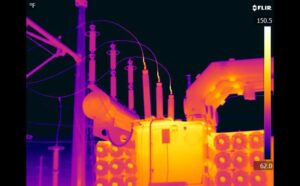Electrical Infrared inspections.
Electrical Infrared inspections find hot spots caused by defects in connections and components. Infrared electrical inspection or thermography is used to find areas of excess heat (caused by increased resistance) so that problems can be corrected before a component fails, causing damage to the component, creating safety hazards and productivity loss. Because increased heating is a sign of failure, infrared electrical inspection is the best diagnostic tool available for finding these hot connections in the early stages of degeneration. This is why your insurance company may have asked for electrical infrared inspections, to find and prevent problems before they cause damage to your personnel, equipment, and facility, thus reducing downtime and less repair costs to the owners, etc.
Electrical infrared inspections
 |
Infrared Inspections Palm Beachshould be an integral part of any electrical preventive maintenance (EPM) program. This type of electrical infrared inspection can help save money by verifying equipment is operating at peak efficiency and reducing costly downtime in the event of electrical system failure. It also can help save the costs associated with the damage that a fire may cause if an electrical system overheats or fails catastrophically. This inexpensive inspection program has evolved into a valuable preventive maintenance tool. The following information discusses the benefits of infrared inspection and explains how the inspections are conducted. The heating effect continued to increase past the red, in a region that is now called infrared (“below red”). He measured radiation effects from fires, candles, and stoves and deduced the similarity of light and heat. Today, devices can be designed to detect, amplify, and display radiation from the visible or infrared portions of the spectrum. Using infrared for electrical infrared inspection and using infrared technology as part of an electrical infrared inspection program works on the principle that electrical equipment normally gives off heat, but malfunctioning or overloaded electrical equipment will give off excessive heat due to increased electrical resistance. This heat can be detected with the use of infrared inspections. Broward and Miami-Dade counties also accept electrical infrared inspections as part of electrical recertification for 40-year or older structures. Using an infrared camera or video recorder, the heat can be converted to an image that can be seen and recorded for analysis. The infrared camera can display various temperatures that are being recorded and the temperature differential between “normal” and malfunctioning equipment. The images can be used to identify exactly what equipment is affected and how serious of a problem exists based on temperatures and temperature differentials. The images can be inserted into a report to help explain the problem and any suggested repairs or improvements. Infrared should be scheduled before a major scheduled shutdown. This allows the greatest flexibility in resolving problems found during the inspection. Infrared inspections are non-destruction tests that should be completed during normal business operations while equipment is running at or near capacity. Equipment should run for at least one hour before inspection. There is no need for downtime or special tear-down of the equipment to perform the electrical infrared inspection. However, equipment covers must be removed to ensure effective scanning. Because busway conductors are so close to enclosures, the covers may not need to be removed during infrared inspections for electrical equipment. |
